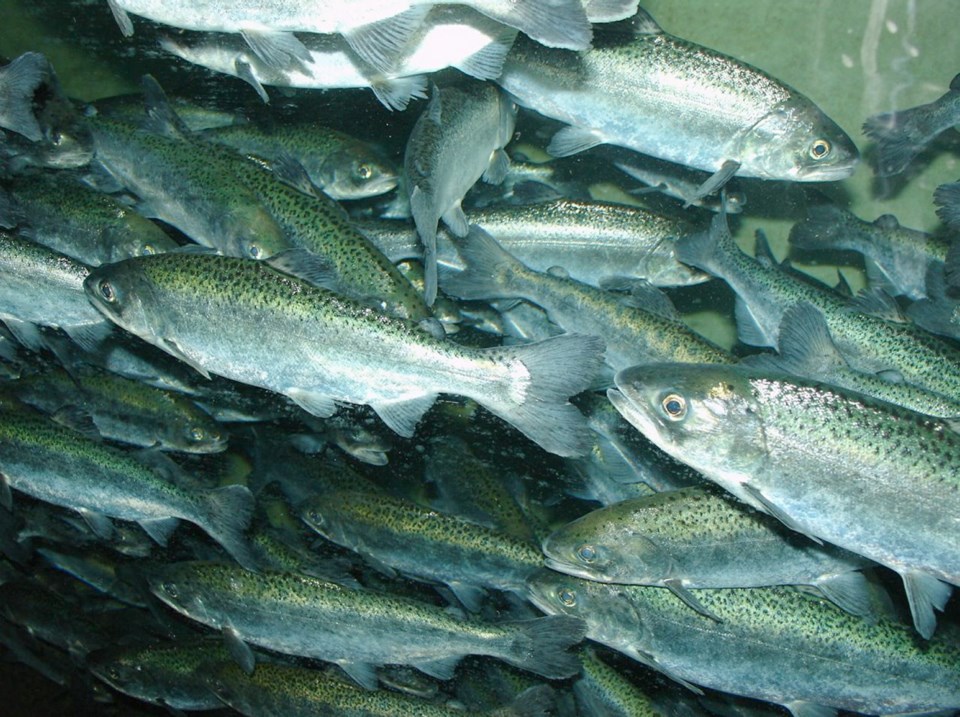B.C.’s sport-fishing sector is hoping to see revisions to proposed federal restrictions aimed at protecting struggling Fraser River chinook salmon runs.
In a Feb. 5 letter to stakeholders, the federal Fisheries Department highlights conservation concerns for chinook and outlines two scenarios put out for discussion, saying other ideas might be considered.
One option has the goal of reducing fishery mortalities to less than five per cent, the other to less than 10 per cent.
The Committee on the Status of Endangered Wildlife in Canada has determined that 12 Fraser River chinook populations are endangered, threatened or of special concern. Another group returning to the Nanaimo River is also endangered.
Last year’s Fraser River chinook returns were lower than numbers seen four to five years earlier, when their parents spawned. These fish were smaller, with fewer females, and they were less able to reproduce.
The results tallied with overall declines in chinook, Jeff Grout, DFO’s regional resource manager for salmon, said in his letter.
Bob Cole, a director with the West Coast Aquatic Stewardship Association, believes it is possible to develop a strategy that will protect fish and at the same time allow for enough fishing to support the sport-fishing sector. By raising the possibility of restrictions, DFO has “done substantial damage,” he said. “People make plans in advance.”
Fisheries and Oceans Canada needs to allow “expectation and opportunity,” said Cole, who recommends allowing anglers to keep one chinook per day in areas where the stocks of concern are travelling.
He said that recreational fishing is “self-regulating.”
Anglers typically do not catch more than 10 per cent of a run because only 10 per cent of returning fish still have the instinct to bite, he said. The catch could be higher, he said, in areas where fish hold before heading up their rivers.
Many in the recreational sector are hoping to reach an agreement allowing some degree of fishing. “You are still allowing the economy to happen, people to go fishing, burn fuel, buy bait, stay in motels, eat in restaurants,” Cole said.
Chinook salmon are prized among anglers because they are the largest B.C. salmon species and they are known for their fight once hooked.
Some of B.C.’s hatchery chinook are marked by having their adipose fin clipped to show they are not wild. The U.S. marks all its hatchery chinook and permits only those fish to be retained, a measure Cole said should happen in B.C.
South of the border, “if you catch a fish that isn’t clipped, you release it,” he said.
“That would save our wild systems,” he said. “By next year, we should be marking all fish. It’s very doable.”
Those with an interest in chinook include First Nations, commercial fishermen, recreational anglers, guides and charter companies, coastal communities with fishing-dependent businesses and environmental groups.
Also called spring salmon, they are the food of choice for endangered southern resident killer whales.
Cole is part of a group calling for 18 sites where hatchery chinook could be raised in ocean net pens and released as food for the orcas. This is happening already in a few locations.
This proposal would also allow chinook to repopulate systems where chinook are no longer found, he said.
“Closing [fisheries] isn’t the answer. Habitat restoration is,” Cole said.
Early Fraser River chinook return from early March through late July, peaking in June. Summer chinook spawn from late June to August.
Fisheries and Oceans has asked stakeholders to respond to its scenarios by March 1. “We are trying to figure out the appropriate method to get as many of those fish back to the spawning grounds as we can,” Grout said in an interview. “We are going to take a close look at the feedback we receive.”
Fisheries would like to begin making fishery announcements in early April, given the timing of the runs, he said.
The department will talk to its integrated harvest planning committee, which includes representatives from the harvesting sectors, and to First Nations groups before making a decision, Grout said.
Under the scenario aiming to reduce fishing mortalities to less than five per cent:
• The commercial troll fishery (hook-and-line boats targeting chinook) would be closed through July on the west coast of Vancouver Island and until July 17 on the north end of Haida Gwaii. This would allow stocks to migrate through the area.
• For recreational fisheries in southern B.C., it would see chinook non-retention in most areas around Vancouver Island.
• The Fraser River recreational fishery would remain closed until late August. Fishing could still occur, but any chinook caught would have to be released.
• There would also be restrictions on First Nations fisheries, especially in the Fraser River.
Under the less-restrictive scenario aiming to reduce fishing mortalities to less than 10 per cent:
• There would still be delayed openings in the commercial troll fishery, but the northern fishery would be closed only until July 10.
• Recreational anglers around Vancouver Island would be allowed to retain one chinook a day. In areas where there are large numbers of hatchery fish, anglers could keep only one hatchery-marked chinook per day.
• The Fraser River would remain closed until late August.
• There would be no new restrictions for First Nations in the Fraser.




